Rising elegantly above the River Thames halfway between the Tower of London and Big Ben is the Temple. Inner and Middle Temples, and beyond them Lincoln’s and Gray’s Inns make up the four Inns of Court in London. Here are time-forgotten havens of shady courtyards, scented gardens, and spooky gas-lit passageways. For hundreds of years, lawyers in their chambers and courtrooms have beavered away, crafting and refining the Common Law.
A young Indian man called Mohandas Karamchand Gandhi studied to be a barrister at the Inner Temple in the 1890s. As he scuttled through legal London courtyards weighed down by volumes of legal precedents did he imagine he would lead the vast subcontinent of India to freedom from British rule wearing nothing but round glasses and a dhoti?
Did he admire the houses of King’s Bench Walk, as unchanged now as when Sir Christopher Wren designed them in the 1600s? Did his shoe squish the fruit of the same Mulberry Trees that can be found in Middle Temple’s Fountain Court today?
Queen Elizabeth I opened Middle Temple Hall in 1576. She gave the benchers an oak table made of trees from her own Windsor Great Park. Barristers and judges still eat at it today. A splendid character,Sir Walter Raleigh was a royal favourite, a long-term prisoner at the Tower of London, pirate and a member of Middle Temple.
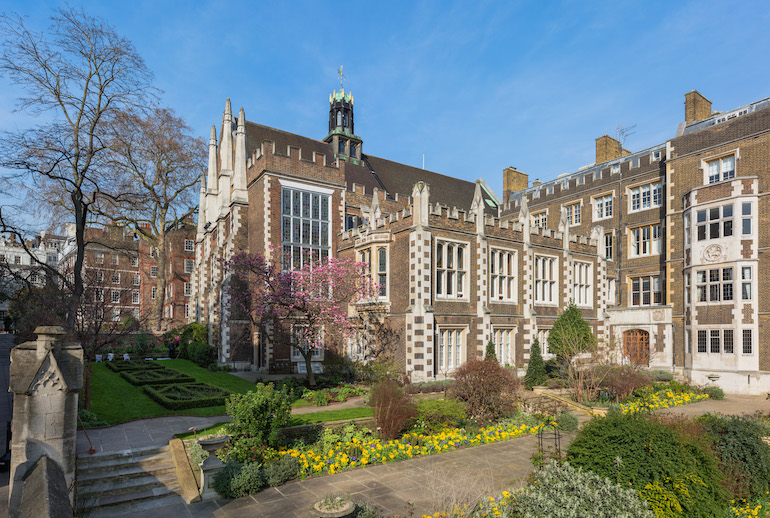 Four Inns of Court: Middle Temple Hall as viewed from the south. Photo Credit: © David Iliff via Wikimedia Commons.
Four Inns of Court: Middle Temple Hall as viewed from the south. Photo Credit: © David Iliff via Wikimedia Commons.
Elizabeth loved theatre and came to see the premiere of William Shakespeare’s Twelfth Night in the hall in 1602. Is that where he met the people of his famous seven ages of man speech? Did he see a judge “full round belly with good capon lined, with eyes severe and beard of formal cut”? It is said that he was inspired by the Temple gardens to write his scene in Henry VI part 1 where royal cousins picked the white or red rose to show which side they supported in the Wars of the Roses.
There are historic ties with the United States of America. Seven signatories to the Declaration of Independence and five to the Constitution were members of Middle Temple. Every United States Ambassador is an honorary member of Middle Temple. A bomb in World War II hit the Hall and damaged it but it has been perfectly restored and it is one of the best examples of medieval architecture in London. Unfortunately, the Inner Temple hall suffered total destruction. It was rebuilt in the 1950s as was the round Temple Church, first built by the Knights Templar in the 1180s. They became the richest and most powerful monks in Europe. So rich that the Pope ordered they be dissolved, their assets stripped and shared out, no doubt some of it went to him. The lucky recipients in England were the Knights of the Order of St John Hospitaller, who provided medical care and support to pilgrims and crusaders. They remained in charge of the church, leasing the land around it to lawyers from the 1300s, until Henry VIII’s dissolution of the monasteries in the 1530s. The monks left but the lawyers stayed. Eventually, King James I gave them the land in 1608 on condition that they maintain the church. It is ravishing inside and out and should not be missed.
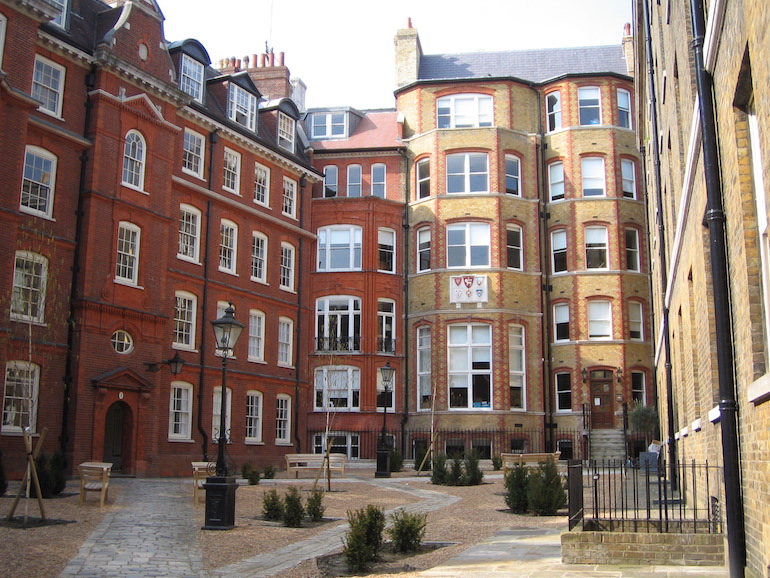 Four Inns of Court: Hare Court, within the Inner Temple. Photo Credit: © Chris via Wikimedia Commons.
Four Inns of Court: Hare Court, within the Inner Temple. Photo Credit: © Chris via Wikimedia Commons.
In the early thirteenth century, it was briefly King John’s headquarters. Here, with the country perched on the brink of civil war, the most powerful man in the country, William Marshall, persuaded the King to agree to a set of demands contained in a document called Magna Carta or Great Charter. It is one of the most important legal documents ever written. Today we may think of the right to a fair trial, or the right not be imprisoned without due process of law as fundamental to any fair and free society but they were written down for the first time in Magna Carta. The King tried to annul the document and ignored its demands. He didn’t last long. It did. Marshall became the Earl of Pembroke and both he and his son are buried in the church.
The grave of eighteenth-century playwright Oliver Goldsmith is in the churchyard. Did he walk down Middle Temple Lane exchanging witty banter with Dr. Samuel Johnson who also lived nearby? They would certainly have been wearing wigs in the 1700s and being slow to change to new fashions, barristers and judges still wear them today.
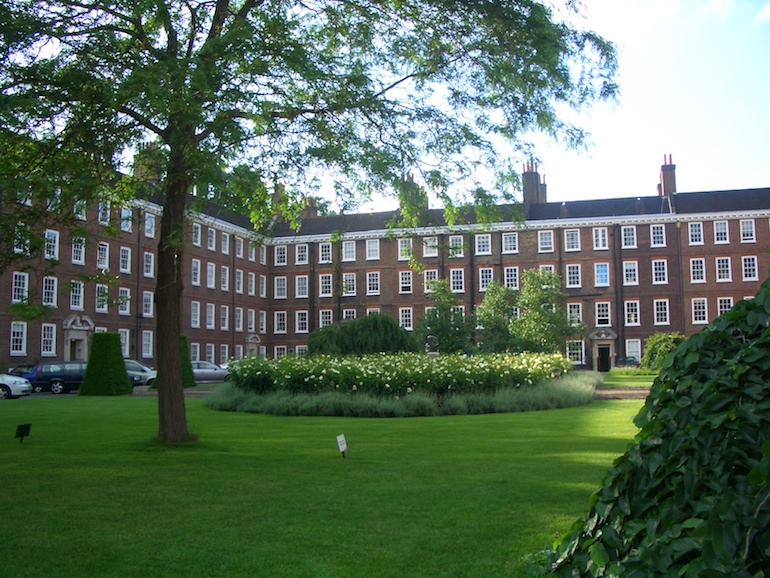 Four Inns of Court: Gray’s Inn Square. Photo Credit: © Chensiyuan via Wikimedia Commons.
Four Inns of Court: Gray’s Inn Square. Photo Credit: © Chensiyuan via Wikimedia Commons.
As a young pupil barrister back in the 1980s I had a black suit with big shoulder pads. Early each morning I would dash into “Chambers” (the office), grab a bundle of “briefs”, folded lengthways and tied with a pink ribbon, and tear off to a court somewhere outside London. I would carry books, wig (kept in a tin and made of horse hair), gown (black, made of “stuff”) and goodness knows what other paraphernalia – no wheelie cases in those days. I frantically read the briefs on the train and prepared my case. I dreamed of being the next Helena Normanton (the first woman to argue a case in court as a Barrister in the 1920s) bravely representing my client with honesty, integrity, and independence as I promised to do when called to the Bar. More often than not I appeared in front of some terrifying old school judge who wasn’t at all moved by my clever phrases and elegant arguments. Oh do get on with it, they’d say testily; I have 20 other careless driving cases like yours to get through this morning.
Sometimes I appeared in the Royal Courts of Justice. A terrible slum was demolished to make way for the gigantic gothic style building. It covers 6 acres north of Fleet Street. George Edmund Street designed it and Queen Victoria opened it in 1882. There is a painting of the event inside. Street is missing because the poor fellow had died of stress and overwork. You can see a statue of him looking rather exhausted in the main hall. The vast building is imposing and frankly rather terrifying. It is easy to get lost in its 3 miles of corridors and over 1000 rooms. Beware of entering one of the courtrooms without obeying strict rules. You could be arrested by tipstaff and thrown into one of the basement jails for contempt of court. However, it is fascinating to creep into the back row of one of the courts and listen to a trial or judgment being given. It is all very theatrical. Barristers and judges still wear wigs and gowns for some cases. Judges are formally addressed as “my Lord” and Barristers call each other “my learned friend”. You still hear Latin phrases used quite often. Everyone knows when to speak and when to keep quiet, when to sit and when to stand up. Characters appear and disappear through different doors too. The judges have theirs to hidden corridors behind their seats – known as “the bench”. Appellants in criminal appeals mostly now appear by video link but if they have to be there in person they will be brought up from the basement cells by a special staircase. This was all thought out and designed in the original building, which is still used every day for the highest value and most important cases.
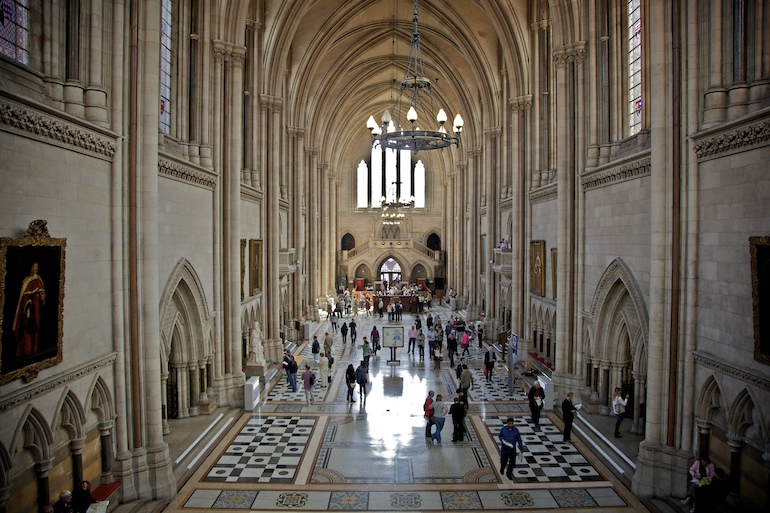 Royal Courts of Justice: The Great Hall. Photo Credit: © Aurelien Guichard via Wikimedia Commons.
Royal Courts of Justice: The Great Hall. Photo Credit: © Aurelien Guichard via Wikimedia Commons.
Lincoln’s Inn claims to be the only place where the monarch is toasted sitting down. It is said that King Charles II was so lavishly entertained when he came to the Inn and everyone was so drunk by the end of the meal that they were utterly “legless” and had to sit for the loyal toast – with the King’s permission of course. The name Lincoln was given to many an abandoned baby left at the Inn, and baptised in the Chapel, in the days when there was awful poverty in the surrounding streets. Sixteen Prime Ministers have been members and some of the most prestigious “sets of Chambers” can be found there. See the names of their members written in lists outside their doors.
Aspiring young barristers are “called to the Bar” when they qualify and are given “rights of audience” by their Inn, meaning the right to present cases in court. All barristers must belong to one of the Inns of Court. A successful career might lead to QC (Queen’s Counsel) also known as “silk” because of silk gowns worn in court. Many of our judges have been senior barristers. In the old days, you had to be a barrister before you could be a High Court Judge. There are different qualifications nowadays but you must be a very experienced lawyer.
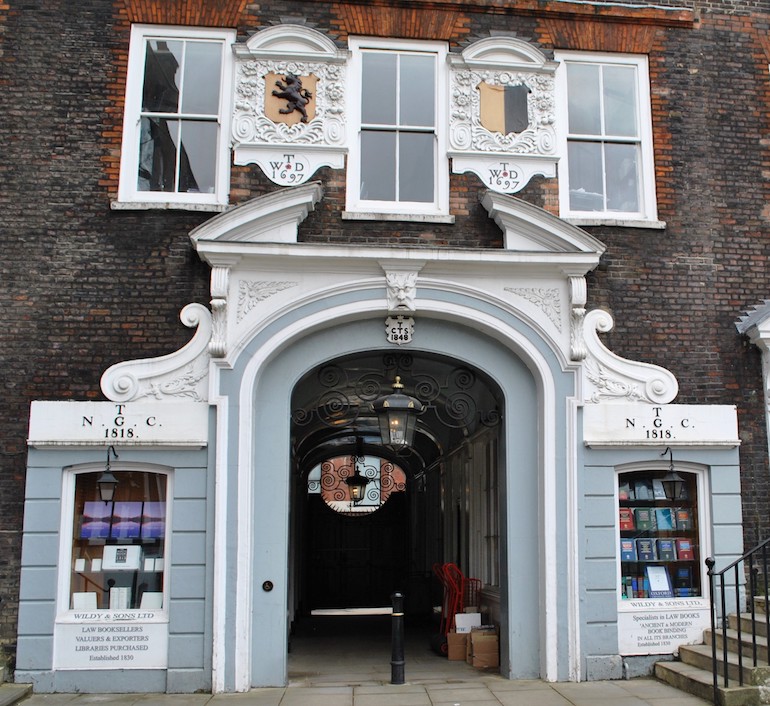 Four Inns of Court: Lincoln’s Inn, building 1 to 4. Photo Credit: © Elisa Rolle via Wikimedia Commons.
Four Inns of Court: Lincoln’s Inn, building 1 to 4. Photo Credit: © Elisa Rolle via Wikimedia Commons.
Television and film producers love the Inns, often using them for shows and movies like The Crown, Downton Abbey, and Mary Poppins Returns to name some recent ones. But Charles Dickens got there long before and set the opening of Bleak House in Lincoln’s Inn. He worked as a law clerk copying dry legal texts in Gray’s Inn. He wrote novels and articles in his spare time and entertained his colleagues by mimicking their clients. He really hated lawyers; read even the first few pages of Bleak House to see what I mean.
There is so much more to Legal London than just a pretty place to walk. Each Inn has its own history, character, and stories. Come and find out more with a knowledgeable and entertaining Blue Badge Tourist Guide.



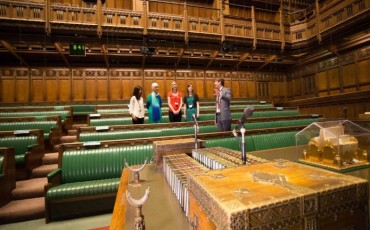
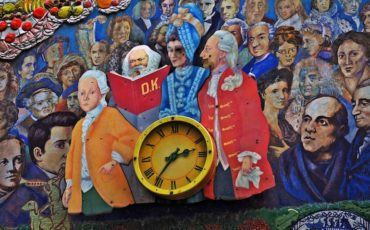


Leave a Reply